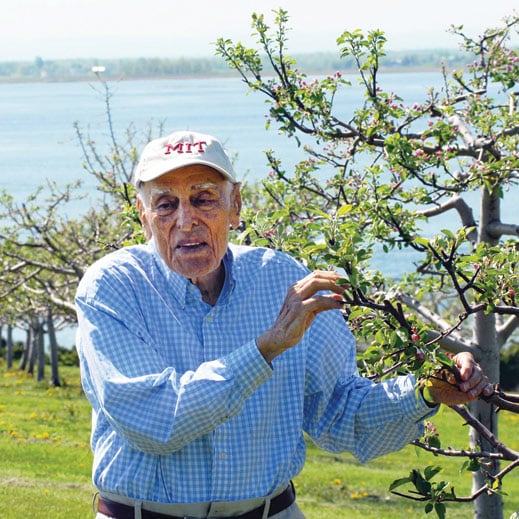Fred Kaneb has been a soldier, petroleum trader, fiberglass manufacturer, and Pepsi distributor. But for the past 40 years in Cornwall, Ontario, he has been a farmer, too.

Managing his orchard of nearly 900 apple and pear trees on the banks of the St. Lawrence River, Kaneb is an engineer of the land. This past spring, he again began the orchard’s harvest cycle, pruning, mowing, and managing pests on his family farm. “I work away at it, six days a week,” says Kaneb, age 94. “It takes five or six weeks to get everything pruned.”
While he used to sell his produce, Kaneb says he can’t compete with large orchards, so he gives his fruit to church groups, food banks, and schools. “Even then, we still have some left over,” he says.
Though known in town for his bountiful crops, he is legendary in the military for a crucial invention. After graduating from MIT in mechanical engineering, Kaneb, a dual citizen of the United States and Canada, entered the Navy Reserve and applied his engineering talent in Pensacola, Florida, home of the U.S. Navy’s flight school. There he led the design of the Dilbert Dunker, a detached cockpit that plunged aspiring pilots deep into a swimming pool upside down to practice escaping crashes at sea.
“The Army colonel said somebody has got to teach them what it is like to be drowning,” Kaneb told a Navy reporter. “It took us six months to a year to design and build it.”
Kaneb was reunited with one of his Dilbert Dunkers last fall when it went on display at the National Naval Aviation Museum in Pensacola. The museum honored him for his contribution in 2009, when he donated his papers.
After his military service, Kaneb moved to Quebec and entered the oil business. He eventually owned OLCO Petroleum and more than 300 gas stations in eastern Canada. Later, his business interests included a fiberglass plant that manufactured truck cabs, a Pepsi distributorship, and a partnership in an oil tanker firm.
Kaneb is most at home on his farm, though, where his four children, seven grandchildren, and five great-grandchildren visit often. In the winter, he snowshoes across the acreage, surveying the deer tracks and taking stock of the pond he designed, the rows of fruit trees he planted, the fire pit where he burns trees blighted with disease, and the irrigation system he built to water the orchard. “We do everything ourselves,” he says of his small crew of helpers, “and everything is pretty good.”
Though he missed his 70th reunion, Kaneb says he’ll be at his 75th. And he occasionally gets a call from his classmate Israel Lenzner ’43, who lives in Florida. Few alumni can share MIT memories that go as far back as theirs.
Keep Reading
Most Popular
Large language models can do jaw-dropping things. But nobody knows exactly why.
And that's a problem. Figuring it out is one of the biggest scientific puzzles of our time and a crucial step towards controlling more powerful future models.
The problem with plug-in hybrids? Their drivers.
Plug-in hybrids are often sold as a transition to EVs, but new data from Europe shows we’re still underestimating the emissions they produce.
How scientists traced a mysterious covid case back to six toilets
When wastewater surveillance turns into a hunt for a single infected individual, the ethics get tricky.
Google DeepMind’s new generative model makes Super Mario–like games from scratch
Genie learns how to control games by watching hours and hours of video. It could help train next-gen robots too.
Stay connected
Get the latest updates from
MIT Technology Review
Discover special offers, top stories, upcoming events, and more.